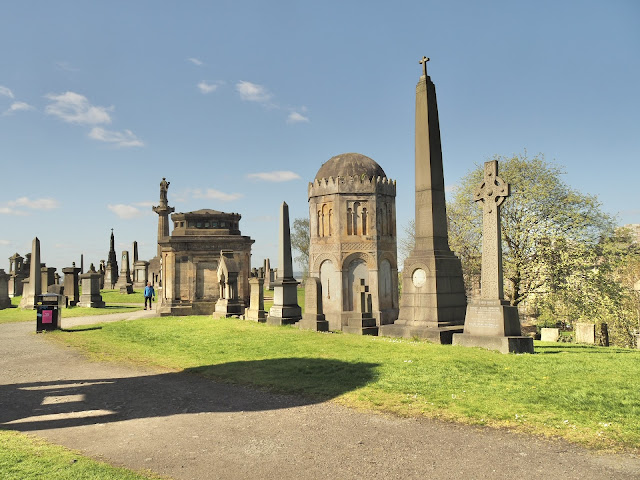Another glorious morning, weather wise.
We set off for Queen Street Railway station to have a look around. The route went via Buchanan Street and Georges Square. Such wonderful buildings and gardens. We were admiring the architecture in the square when we were stopped by a local and asked if we spoke English. This was because we were obvious tourists as locals tend to look down heading to work whereas we were looking up and taking pictures. We spoke for about 30 minutes, reminiscing about old Glasgow, about Manchester United and he was on his way to Dubai to help his daughter out who was caught up in the terrible flooding there. We could have chatted longer but we sadly had to move on.
Queen street station was quiet even with the morning rush, we didn't stay too long as it isn't as elaborate as Central.
Our plan for today was to go to Glasgow Cathedral and to the Necropolis which we had seen in numerous documentaries and films on TV. We made our way past the Town Hall, another stunning building, past the University buildings until we came across many more murals which had to be photographed. We even had to wait at some of them until a crowd of Australian Tourists had finished admiring the art work.
Then it was uphill along High Street, aptly named, directly to the Cathedral and the oldest house still surviving in Glasgow.
The Cathedral doesn't charge to enter unlike the counterparts in England. It didn't let us down, just a fabulous place to visit. It is the oldest Cathedral on mainland Scotland and it is the oldest building in Glasgow. This Cathedral and St. Magnus in Orkney are the only two medieval Cathedrals in Scotland to escape the destruction during the reformation period.
The Cathedral is dedicated to St Mungo the patron saint of Glasgow, it dates from 1136 but the current building is mainly 13th Century. The tomb of St. Mungo is still in the lower part of the Cathedral and can be visited.
Names of the more famous are John Knox, John Henry Alexander, Charles Tennant and the author of the famous "Wee Willie Winkie" William Miller. There's a whole list on Wikipedia if anyone wishes to read the whole list.
There is also a small Jewish Cemetery just outside of the Christian site. It was restored in 2015 and contains 57 burials.
We found a nice spot with a view for lunch before chatting to a couple from Miami who were complaining that it was too hot here! What!
From here we walked the short distance to the oldest house which was again free entry. We were given a brief introduction the history of the building by a guide and then we wandered around on our own.
It's a fascinating building. I don't know why it was rendered because it wasn't originally. If I had noticed earlier I would have asked the guide.***
The rear of the building which is a walled garden grew herbs and plants for medicines for the hospital nearby. Now the gardens are a quiet area where you can go and sit and contemplate life.
Inside, the building is mainly furnished with 17th century furniture and many royal portraits hang on the walls. It has had a number of building changes over the years from clergy housing to shops and even a public house.


























Excellent and interesting. That second door latch looks as though it gave inspiration to the designer of those galvanised contraptions on gates in our countryside to enable horsey folk to get through without dismounting. Guess which one I find the most aesthetic.
ReplyDeleteThanks Conrad. They made simple things beautiful and I guess you would prefer this one over the modern one.
Delete